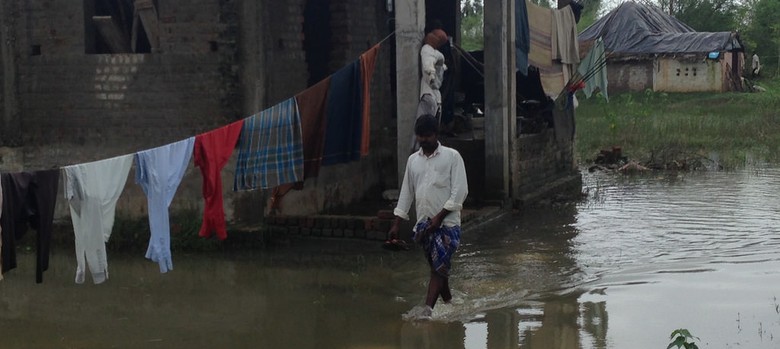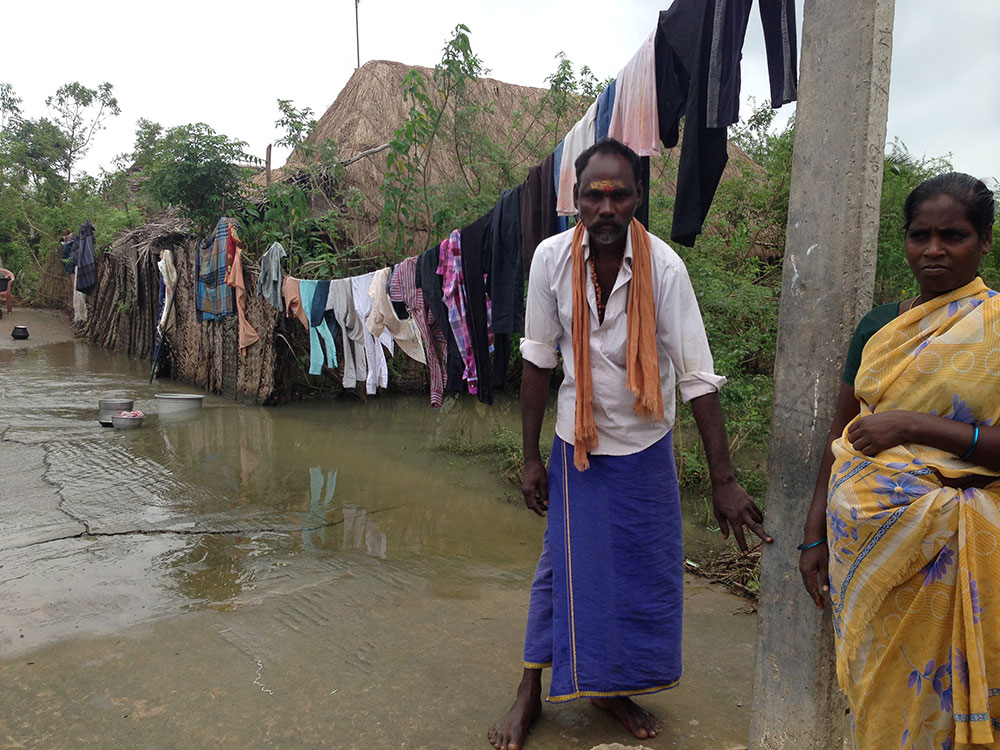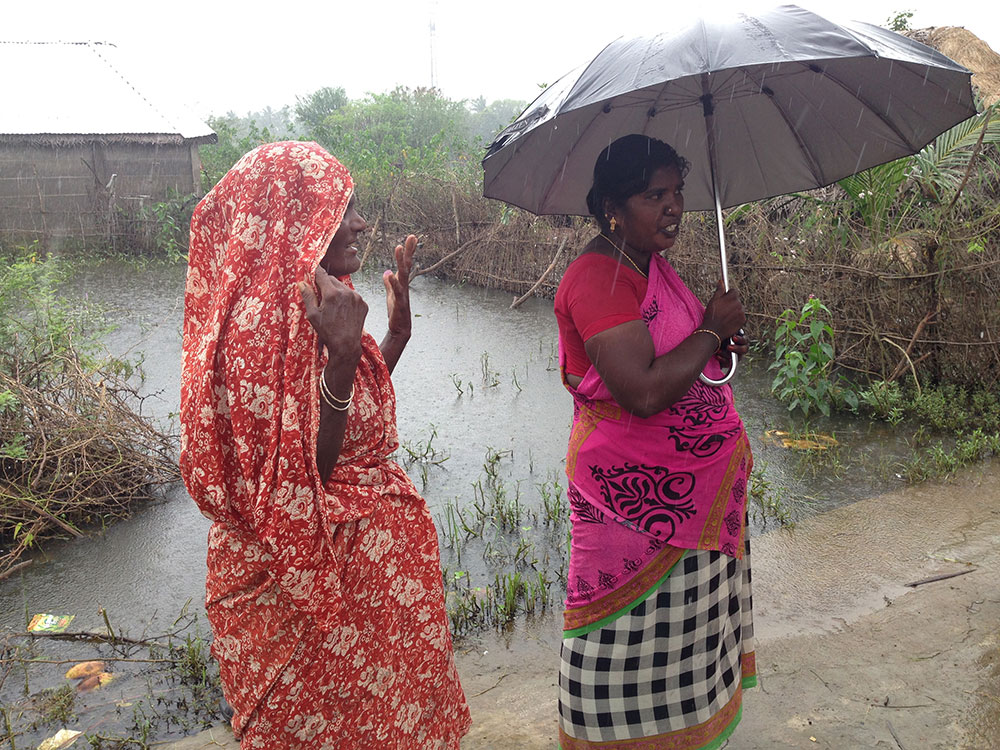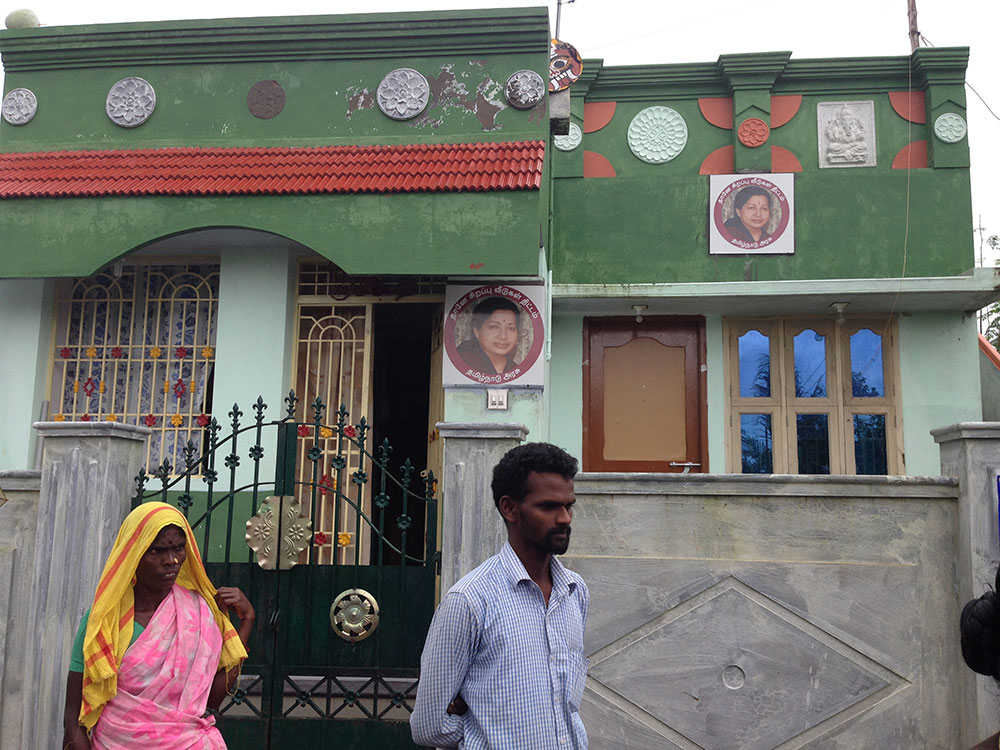
There are 45 houses in Ambedkar Nagar of which only 11 are made of concrete. There others are all mud and thatch structures. On the night of November 10, as the rest of the country was caught up in Diwali festivities, Ambedkar Nagar, along with large parts of Cuddalore experienced its worst flooding in a century. The district got 50% more rainfall on November 9, 10 and 11 than the normal rainfall for the entire month of November.
As water rushed in from a nearby river, some of the mud houses were completely washed away. Others were severely damaged. As the rain continued for the rest of the month and into December, the stubborn waters refused to recede from the streets and houses of Ambedkar Nagar. Residents like A Subramaniam say that little help has come to them and they have nowhere to go.
“My wife, five children and I have been staying here only,” said Subramaniam, who had to wade through shin-deep water to enter his house a month after the first floods, when at least two feet of water entered his house through the thatched back wall and destroyed, among his other belongings, his refrigerator. Subramaniam acquired a plastic poster from a nearby temple to cover the gaping hole in the back wall.

Subramaniam, standing near the flooded street to his house, indicates the level of water in the second week of November. Photo: Nayantara Nayaranan
“My feet are full of sethu punnu from walking around in all this water,” Subramanian said while displaying the wounds on his feet due to intertrigo, a condition in which sores develop due to bacterial or fungal infection of moist skin. When asked if he had reached out to authorities or other people in the district for help, Subramanian only said quietly, “No relief material has come to us. We can’t go and ask anyone also.”
Dalit villages like Ambedkar Nagar have not only been the hardest hit by the floods, they have also been excluded from relief operations, according to a report by the National Campaign on Dalit Human Rights and the Social Awareness Society for Youth in Tamil Nadu. The report, based on a survey of 8,400 houses in Cuddalore district, found that out of 1,337 houses that were damaged 1,276 belonged to Dalits. Among the 433 acres of crop lost, 378 belonged to Dalits.
This unequal damage, the report says, is due to the fact that Dalit settlements are relegated to low-lying areas near rivers, streams or canals at an average distance of 1.5 kilometers from the main villages they are attached to. Ambedkar Nagar, for example, is located on the near the Kollidam river about half kilometer away from the main Kavarapattu village that consists of about 400 Kallar households, a Most Backward Caste group. Ambedkar Nagar residents said they hadn’t received any warning about flooding in their area or a visit from any government official in the aftermath.
Subramaniam and his neighbours have been left in the cold when it comes to aid because of the inherent caste-bias among government officials too, according to Pandiyan Kamal, director of the Social Awareness Society for Youth. “Whenever disaster occurs, Dalit people are excluded from relief assessment and emergency response,” he said. The report also alleges that political strongmen in neighbouring villages are blocking the flow of relief material into Ambedkar Nagar.
“Even if we ask for help, when we say we are in Kavarapattu, they won’t come. I don’t know why they are scared to come,” said Pavai.
Flood after flood after flood
This isn’t the first time that Ambedkar Nagar has battled flood waters. When the tsunami hit in 2004, the waters flooded the village and receded in a day. Then came Cyclone Nisha in 2006 and then Cyclone Thane in 2011, each one slamming into the village. Most of the 11 concrete houses that have been built or are under construction are from the funds allotted for rehabilitation of Cyclone Thane’s victims.
Pavai holds up an umbrella as rain continues to taunt the still flooded village. Photo: Nayantara Nayaranan
“Each household gets Rs 120,000 to build a concrete house but the money can only be claimed after submitting the bills,” said Pavai, who is the cluster leader of a grassroots federation called Inaindha Kaigal – joined hands – set up by the Social Awareness Society for Youth. “So people here are slowly building their houses from their savings. For some people, building has been going on for more than three years. They build a little more each time they have saved up enough.”
Near the entrances of the few houses completely constructed from Cyclone Thane funds, are mandatory pictures of Tamil Nadu Chief Minister J Jayalalithaa.
House constructed with Cyclone Thane relief funds. Photo: Nayantara Nayaranan
Kalkunam village in the Kurinjipadi block west of Parangipettai was one of the worst affected villages this season, registering two deaths and at least 250 houses of its 300 houses destroyed. “For at least a week, we were in the same clothes,” said John Bose, who lives on the Dalit and Christian side of Kalkunam. “We normally get 20 kilos of free rice from the ration shop. We are making full use of that. For vegetables we are making do with whatever little comes from the NGOs.” Aid has started trickling into Kalkunam since local press started reporting the destruction, but only after Chennai had its worst rains in the beginning of December.
Jasmine Mary has been living in the community hall of Kalkunam church with her seven-month baby and son attending third standard at the local school. She has been struggling to get by on the Rs 3,000 compensation the government has given her for her destroyed hut. “I have already spent Rs 1,500 to buy my son’s school books that got washed off in the rain. Then there is milk for the baby and lots of other things.”
The remains of Jasmine Mary’s house
While the people in Kalkunam are struggling to get back on their feet, those in Ambedkar Nagar don’t even now how. Ambedkar Nagar hasn’t got the meager attention or compensation that Kalkunam has. It has neither a house of worship or a community hall to serve as temporary shelter. Families are scrounging for any sort of covering to lay on still damp floors before they sleep.
More than ten years ago, the families of Ambedkar Nagar lived on higher ground but were moved to their present location to make way for a road. “For the last four or five years, every time the water comes, it’s same problem over and over again,” said Pavai. “In this place, there isn’t even space to bury our bodies when we die.”






